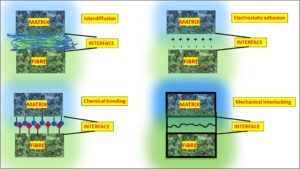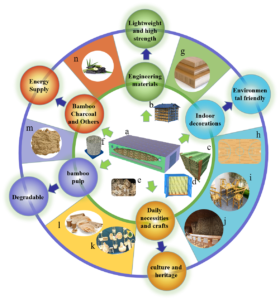Volume 17 Issue 4
Latest articles
- Reviewpp 6997-7030Tazeddinova, D., Toshev, A. D., Abylgazinova, A., Rahman, M., Matin, M., Bin Bakri, M. K., and Ayan, O. (2022). "A review of polyphenol and whey protein-based conjugates," BioResources 17(4), 6997-7030.AbstractArticlePDF
Proteins act as a primary food component obtained from different food sources. In contrast, polyphenols are metabolites and are abundantly present in plants, so their combination plays a crucial role in defining the functional properties of a food product. In the current review, the protein-polyphenol interactions have been briefly reviewed, along with the changes that occur because of their interaction. The mechanisms and the factors affecting the functionalities of the protein-polyphenol conjugates, e.g., the solubility, antioxidant, and gelling properties, have also been briefly reviewed. In addition, the interaction of polyphenols with whey proteins was been reviewed with various applications within the food industry, e.g., emulsifiers, foaming agents, and antioxidants. To end the review, future challenges were also highlighted.
- Reviewpp 7031-7090Mohammed, M. M., Rasidi, M., Mohammed, A. M., Rahman, R. B., Osman, A. F., Adam, T., Betar, B. O., and Dahham, O. S. (2022). "Interfacial bonding mechanisms of natural fibre-matrix composites: An overview," BioResources 17(4), 7031-7090.AbstractArticlePDF

The development of natural fiber (NFr) composites for a variety of applications is on the rise. The optimization of the interfacial bonding (IFB) between the reinforcing NFr and polymer matrix is perhaps the single most critical aspect in the development of natural fibre polymer composites (NFPCs) with high mechanical performance. While the IFB is critical in determining the mechanical properties of the NFPCs, such as stress transfer, it is one of the least understood components. This article offers a summary of IFB mechanisms, different modification approaches targeted at lowering incompatibility and improving IFB, and evaluation of the impact of IFB. It has been found that 1) In general, interdiffusion, electrostatic adhesion, chemical reactions, and mechanical interlocking are accountable for the IFB; 2) the incompatibility of the fibre and matrix, which results in poor dispersion of the fiber, weak IFB, and ultimately worse composite quality, may be addressed through strategic modifications; and 3) Interfacial interactions between polymers and nanoparticles (NPs) are significantly improving their performance in areas like thermal, mechanical, robust IFB, and moisture absorption. As a result, this review study could be an important resource for scholars interested in coating and treating NFr to further enhance their surface characteristics.
- Reviewpp 7091-7109Jia, H., Fang, C., Liu, H., Zhang, X., Ma, X., Sun, F., and Fei, B. (2022). "Designing an improved strategy for Chinese warehouses to store bamboo and its semi-finished products," BioResources 17(4), 7091-7109.AbstractArticlePDF

Bamboo plants are fast-growing, quickly produce usable material, and are an abundant resource. Bamboo is an excellent, natural, and renewable material. It has a long history of application in human life, industrial manufacturing, cultural industries, and other fields. The warehousing of bamboo and its finished products is an emerging industry with much potential. A reasonable, stable, and orderly warehouse could be an effective solution for the sustainable management, seasonal harvesting, and raw material stability issues. In addition, the warehouse plays an important role in the processing of raw materials, reserve logistics, keeping a robust and real-time supply for downstream products. This is of great significance for alleviating problems associated with Chinese timber safety and for improving the quality of life. This paper focuses on warehousing experience in grain and coal fields, reviews the common material processing and preservation measures of bamboo, analyzes advantages and developmental prospects of bamboo warehousing, and explores and suggests appropriate storage methods, technical systems, and application models. It is expected to provide technical guidance for construction in the bamboo storage industry, and to supply ideas and suggestions for the modern development of the bamboo industry.
- Reviewpp 7110-7134Tazeddinova, D., Rahman, M. R., Hamdan, S. B., Matin, M. M., Bin Bakri, M. K., and Rahman, M. M. (2022). "Plant based polyphenol associations with protein: A prospective review," BioResources 17(4), 7110-7134.AbstractArticlePDF
This review discusses the classes of plant polyphenols along with their binding mechanisms with protein molecules. Generally, polyphenols bind in covalent and non-covalent orientations with protein molecules. Their addition to the protein usually results in undesirable flavors and tastes inside the proteins. They also affect the color of the food. Plant polyphenols are found to act in a protective way against cardiovascular disease, neurodegenerative diseases, diabetes, and cancer. In addition to redox activity, their modes of action include the inhibition of key enzymes, modulation of transcription factors or cell receptors, and finally, perturbation of protein aggregates. Dietary polyphenols usually play a key role in protein digestion by forming covalent and non-covalent bonds with proteins. In addition, polyphenols and plant phenolics possess the scavenging ability of reactive oxygen species (ROS), including radical/non-radical oxygen species including HOC•, H2O2, HOCl, 1O2 (singlet oxygen), and oxidatively generated radicals derived from LDL biomolecules such as ROOC• and oligonucleic acids.
- Reviewpp 7135-7166Kong, Y., and Fu, S. (2022). "Computer simulation in lignocellulosic biomass conversion processes: A review," BioResources 17(4), 7135-7166.AbstractArticlePDF
Much attention has been paid to the solubilization and conversion processes of cellulose, hemicellulose, and lignin to produce high value-added chemicals and fuels. Computer simulation shows great potential in understanding the conversion process of plant biomass. This paper reviewed the solubilization processes, catalytic conversion, and pyrolysis of cellulose, hemicellulose, and lignin by density functional theory and molecular dynamics. The authors also provide prospects for the challenges and future developments in this area.
- Reviewpp 7167-7249Hubbe, M. A., Szlek, D. B., and Vera, R. E. (2022). "Detergency mechanisms and cellulosic surfaces: A review," BioResources 17(4), 7167-7249.AbstractArticlePDF
The release of soils and impurities from cellulosic surfaces plays a critical role in such processes as the laundering of clothes and the deinking of wastepaper pulps. This article reviews publications that provide evidence about factors that affect such release and the mechanisms by which such factors operate. In general, cellulosic substrates provide advantages for the release of contaminants due to their hydrophilic nature and due to their permeability, allowing the transport of surfactants to contact interfaces with dirt. However, the same permeability of cellulosic material also provides opportunities for contaminants to work themselves into internal crevices and pores, from which they are difficult to remove. The article also reviews aspects of theory related to detergency and how those theories relate to the laundering, deinking, and purifying of substrates based on cellulose and related plant materials. Cellulose and some of its derivatives also can play a role in detergent formulation, especially as builders or as finishes placed on textile surfaces, which sometimes aid in the release of dirt.
- Reviewpp 7250-7266Shi, D., Hu, X., Hong, W., Zhang, J., and Du, H. (2022). "Review of connections for timber-concrete composite structures under fire," BioResources 17(4), 7250-7266.AbstractArticlePDF
A timber-concrete composite structure has the advantages of energy saving, environmental protection, and low carbon, and has wide application prospects. However, the effects of fire on timber-concrete composite structures are complicated. It is important to study the fire performance of connections and their influencing factors for the promotion and application of timber-concrete composite structures. This paper summarizes the research progress of connections for timber-concrete composite structures under fire. Firstly, research on the performance of connections in timber-concrete composite structures under fire is introduced, including screwed connections, notched, and grooved connections, and steel truss plate connections. Secondly, the calculation methods focused on connections of timber-concrete composite structures under fire are introduced. Finally, the main points of modeling timber-concrete composite structures under fire are also briefly introduced.
- Reviewpp 7267-7284Kemmer, A., Qi, H., and Heinze, T. (2022). "Clickable polymers accessible through nucleophilic substitution on polysaccharides: A sophisticated route to functional polymers," BioResources 17(4), 7267-7284.AbstractArticlePDF
This review article is dedicated to special polysaccharide esters – the polysaccharide toluenesulfonic acid esters (tosylates) and polysaccharide carbonate esters. After describing the specifics of the synthesis, particular emphasis is placed on the use of polysaccharide tosylates and polysaccharide phenyl carbonates for subsequent modification by nucleophilic substitution (SN) reactions. For this purpose, the advantages and limitations of the respective derivatives are discussed with regard to their application in chemical modification with nucleophiles containing functional groups. A few functional polysaccharide derivatives and their properties are presented. Finally, reactive derivatives for click chemistry approaches are featured. These can be prepared starting from the reactive intermediate of either polysaccharide tosylate or polysaccharide phenyl carbonate.
- Reviewpp 7285-7312Baala Harini, A., and Rajkumar, R. (2022). "Development of sustainable bioproducts from microalgae biomass: Current status and future perspectives," BioResources 17(4), 7285-7312.AbstractArticlePDF
Population and pollution make notable contributions to introducing novel sophisticated techniques. From vehicles to industries, the release of CO2 into the atmosphere and wastewater into the running water streams are key concerns. On the other hand, the population is responsible for the rapid manufacturing of all commercial goods. Microalgae are the only answer accessible for the aforementioned difficulties. Similar to plants, microalgae need CO2 and light to thrive and produce a variety of bioproducts such as carbohydrates, protein, lipids, vitamins, sterols, pigments, and silica. Physical (light, temperature, CO2, and UV), chemical (nutrient addition or depletion), enzymatic, and metabolic pathway reconfiguration, as well as indoor or outdoor growing, are highly regarded among the several optimization strategies to make desired products. Wastewater pollution is rectified by growing microalgae in nutrient-rich organic water for their growth, which is used to accelerate bioproducts. This review considers the use of bioproducts in food, animal and aquatic feed, fertilizer, biofuel, medicinal and nutraceutical sectors. This paper also provides different optimization strategies, which include physical and chemical means of extraction methods for enhancing bioactive products. Challenges and future recommendations for enhancing target bioproducts are discussed to overcome environmental issues.
- Reviewpp 7313-7337Mendieta, C. M., González, G., Vallejos, M. E., and Area, M. C. (2022). "Bio-polyethylene furanoate (Bio-PEF) from lignocellulosic biomass adapted to the circular bioeconomy," BioResources 17(4), 7313-7337.AbstractArticlePDF
There is a global trend to replace the production of conventional recyclable plastics with biobased ones, allowing a sustainable alternative adapted to the current concept of a circular bioeconomy. Forest-industrial and agricultural biomass wastes (lignocellulosic biomass waste, LCBW) produce severe problems in some developing countries because they are improperly disposed of or burned in the open air. Such wastes are attractive as a raw material to produce bioplastics due to their low cost. Furthermore, low-pollution processes can complete an economical and environmentally friendly approach. This review focuses on bio-polyethylene furanoate (PEF) production from LCBW as an alternative for polyethylene terephthalate (PET), one of the most widely used fossil-based plastic. The standpoint is based on the replacement of fossil-based monomers for the manufacture of PET, terephthalic acid (TPA), and ethylene glycol by two bio-based monomers, namely 2,5-furandicarboxylic acid (FDCA) and bio-ethylene glycol (Bio-MEG). This study describes the processes to obtain each bio-monomer, as well as the resulting polymers’ performance aspects, biodegradability, environmental and economic considerations, and recycling.
